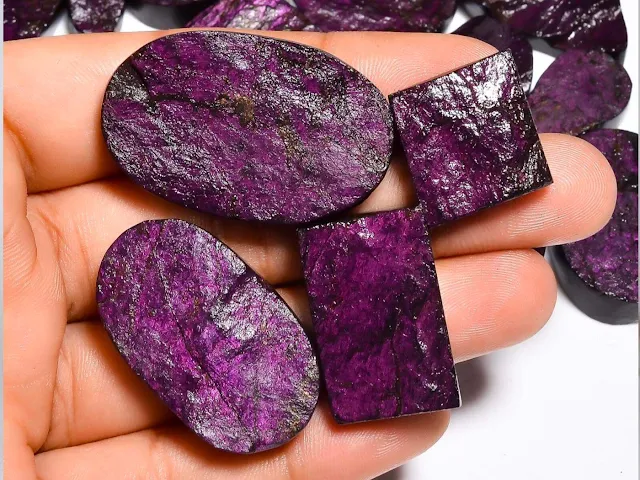Purpurite: Gemstone, Properties, Uses
Purpurite is a rare, purple gemstone with a vibrant, almost iridescent color.
Purpurite is a manganese phosphate mineral with the formula MnPO₄, but it can also contain varying amounts of iron, leading to a range of colors from brownish black and violet to dark red and reddish purple.
The name "purpurite" comes from the Latin word "purpura" for "purple," aptly describing its most common hue.
 |
| Polished Purpurite stone. |
Purpurite Formation
Purpurite is a secondary mineral, primarily formed through the alteration of lithiophilite, a lithium-manganese phosphate mineral typically found within pegmatites.
Transformation process: Two key geochemical processes are involved:
- Oxidation: Manganese ions (Mn²⁺) within the lithiophilite lattice undergo oxidation to Mn³⁺ due to electron loss, impacting the mineral's structure and color.
- Leaching: Lithium ions (Li⁺) are dissolved and transported away by external fluids, creating vacancies within the lithiophilite structure and destabilizing the mineral.
Crystallographic transformation: As oxidation and leaching proceed, the altered lithiophilite gradually transforms into purpurite. Vacancies left by Li⁺ are occupied by Mn³⁺, resulting in the characteristic Mn³⁺PO₄ composition of purpurite. This rearrangement leads to the loss of the original lithiophilite color and the emergence of purpurite's distinctive violet-purple hue.
 |
| Purpurite |
Purpurite Properties
Composition: Mn³⁺PO₄ (Manganese(III) phosphate)
Color: Deep rose to reddish purple; may alter on the surface to brown or black due to oxidation.
Luster: Vitreous to subvitreous; sometimes silky on cleavage planes.
Crystal System: Orthorhombic
Streak: Purple
Hardness: 4-4.5 on the Mohs scale (relatively soft)
Cleavage: Good in one direction (100), imperfect in another (010).
Crystal Form: Typically massive, granular, or botryoidal; rarely occurs as well-defined crystals.
Density: 3.20-3.69 g/cm³
Transparency: Opaque
Fracture: Uneven, irregular
Solubility: Insoluble in common acids and water
Magnetism: Non-magnetic
Fluorescence: Weak to non-existent (may show pale red luminescence under longwave UV)
Pleochroism: Distinct, from violet to lavender to pale yellow
Refractive Indices: nα = 1.85-1.86, nβ = 1.86-1.87, nγ = 1.92-1.93 (double refractive)
 |
| Polished Purpurite |
Where is purpurite found?
Purpurite is a relatively rare mineral found primarily in pegmatites, which are coarse-grained igneous rocks. Here's a more detailed breakdown of its locations:
Main locations:
Namibia: The Usakos mine in Namibia is the main source of gem-quality purpurite, producing rich, purplish masses in abundance and at a lower cost.
United States: Purpurite can be found in several states, including California, Maine, North Carolina, and South Dakota. However, the deposits are typically smaller and of lower quality compared to Namibia.
Other locations:
Western Australia: Some localities in Western Australia yield purpurite, though usually in smaller quantities and lower quality than the main sources.
France: The Bendada Mine in Portugal has produced some notable purpurite specimens, known for their unique matrix.
Portugal: Smaller deposits of purpurite have been found in various locations within Portugal.
 |
| Rough Purpurite from Namibia |
Uses of Purpurite
Gemstone: While not as popular as some other gemstones, purpurite can be cut and polished into cabochons or faceted stones for jewelry. Its vibrant color and unique properties make it a collector's item for those who appreciate rare and unusual gems.
Metaphysical: In crystal healing, purpurite is associated with opening the third eye and crown chakras, promoting spiritual growth, intuition, and psychic abilities. It's believed to help one connect with higher realms and gain insights into their life path.
Collectible: Rare and high-quality specimens of purpurite are sought after by mineral collectors and enthusiasts. Its beauty and interesting formation process make it a valuable addition to any collection.
 |
| Polished Purpurite |
Facts about Purpurite
Purpurite is sometimes artificially treated with heat or acid to enhance its color or clarity. While this can make it more attractive for jewelry, it's important to be aware of such treatments when purchasing.
Purpurite is often misidentified as other minerals like charoite or sugilite due to its color. However, its softness, purple streak, and specific gravity can help in identification.
Purpurite forms a series with the iron-bearing endmember called heterosite. They are very similar in appearance, making it important for experts to distinguish between them.
Read also:
Sugilite - Formation, Occurrence, Properties, Uses
Charoite - Formation, Properties, Uses
Purple Gemstones and Crystals








